They are among the flashiest horses in the flashiest classes — the American Saddlebred horses in the three- and five-gaited events. Like barely controlled dynamos, they charge around the ring with high knee action, willowy necks and proudly held heads. Even casual observers unfamiliar with the breed tune into the excitement and the drama that these creatures create when they strut their stuff.
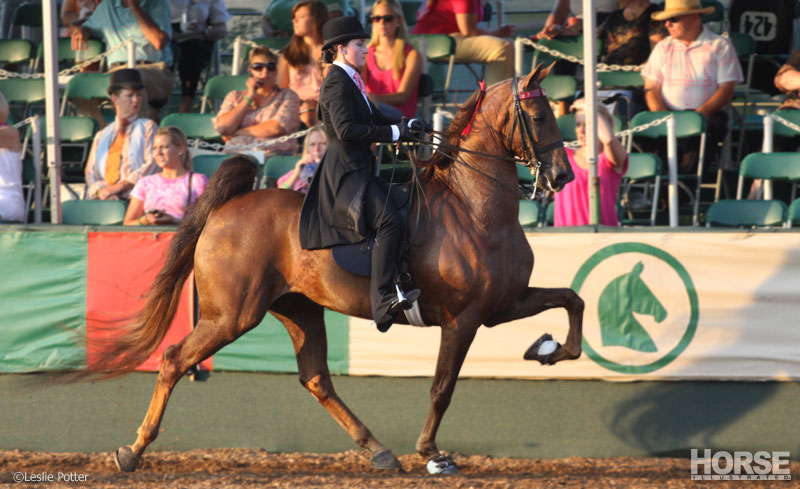
Classy Matches
When putting a green horse into three-gaited or five-gaited training, the first consideration is recognizing the class for which the horse shows the most natural potential: A horse seldom does well in both disciplines. “The horses themselves help us decide which class by the stride of their gait,” explains Nichols. “The three-gaited horse has a more elegant look, and is much more refined up through the neck, ears and head. They do a park trot, which is a slow and animated trot, and have a lot of action off both ends.”
In contrast, the five-gaited horse is a little bolder with a more powerful, muscular look, and trots more quickly. “With the slow gait and rack, the horse only has one foot on the ground at a time, which is pretty strenuous,” says Beard. “That’s why a bigger, stronger horse is usually selected for five-gaited training.”
This decision is not always made just by simply analyzing conformation and way of going: Many horses need to undergo basic training — ground work, walk and trot — before a trainer can see which class the horse is best suited for.
Basic Training
Nichols begins training young horses in the fall of their first year. “We begin handling them in most every way we can,” he says. “Getting them used to being indoors, being around people, handling their feet, cross-tying, grooming, et cetera.” Next, Nichols works on ground driving, teaching the youngster to turn, stop, stand, back up and go forward. The horse is tacked up in a back pad, surcingle, martingale, bridle and sometimes a soft rubber bit. In the very beginning, Nichols runs the lines down along the side of the horse, right above the hocks. “You can help maneuver his whole body when you pull him to the right or the left with your line around him,” he explains. “We teach him to connect to the ‘cluck’ in getting him to move, the basics of what the rider is going to be asking him to do, and trying to get him to relate to the rider. We start him at the walk, and as he learns guiding and maneuvering a little bit and going in a circle, we ask him to step up to the trot.”
After two or three weeks, the young horse is usually ready to move on to mounted work. “We put a saddle on his back and lead him around a little bit to get used to the different equipment,” says Nichols. “When he’s settled with that, we’ll ease somebody on his back, then lead him around for about five minutes or so, taking this process really slow to make him understand that nothing is going to hurt him. If everything seems to be going okay, we’ll turn him loose and start working on the guiding and signals that the rider will be giving him.” Once the horse is comfortable with a rider, he’s ready to move into three- or five-gaited training.
Teaching the Triple
Training the three-gait begins with simultaneously teaching the trot under saddle and with a cart. “Jogging in the cart teaches your horse to go forward in a straight line because he’s between the shafts of the cart,” says Beard. “Going forward is the most important thing you can do with a horse.” Working in a cart also gives the horse a break from mounted training, keeping the young mind fresh, and it provides good conditioning without stress.
To accustom the horse to the cart, assistants at the horse’s head lead him around while others follow the cart to keep it from twisting and scaring the young horse.
Once the horse is comfortable pulling the cart, Nichols asks for a trot by clucking, gives a little bit of line and lightly slaps the line on the horse’s back. Helpers at the head encourage the horse to move into a trot and discourage him from breaking into a run.
From the saddle, Nichols asks the horse for a trot by similar means: clucking, lightening up on the mouth, sometimes tapping a rein on his back and applying pressure evenly with both legs. Other aids include “whoa” plus taking back to stop; “whoop” in tandem with lightly taking a hold of the reins or lines to slow; and “cluck” coupled with lightening the mouth, applying a little leg and a tap on the side with legs or lines to quicken.
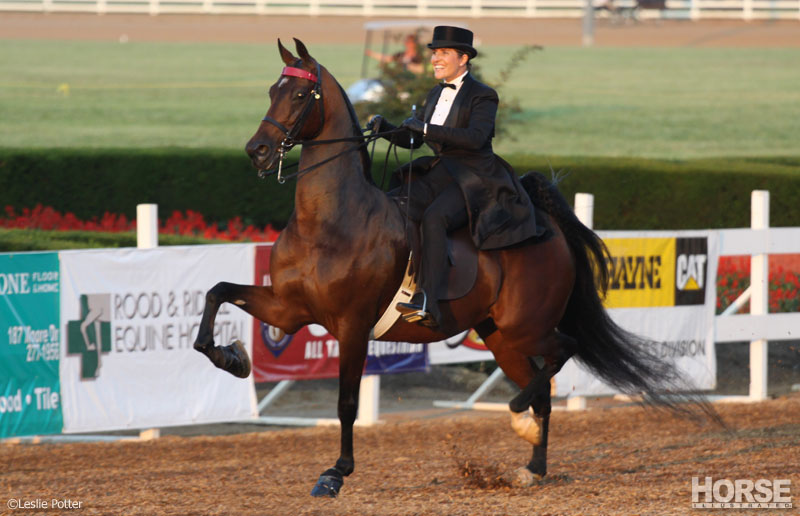
When the horse understands his trotting aids, Nichols begins working on head carriage. To set the head, Nichols starts him on a long line or under saddle with a snaffle bit, but no overcheck or check bit. “When the colt is guiding and seems pretty happy about everything, I’ll add a check bit to help keep the horse’s head up,” Nichols says. “It can either be a sidecheck, which runs up to the side of the bridle, or an overcheck, which runs up over the horse’s face, up between his ears and hooks to the back pad. We start with it pretty loose, just to keep him from really rooting his head way down. As time goes on and he gets more settled with it, we keep tightening it up a bit, and that’s where we get a lot of the elevation.”
After the horse is trotting reliably, usually within three months, Nichols begins teaching him to canter under saddle. By clucking and thumping the sides, the horse tends to break into a canter. The first few times, the young horse may canter quickly, but with time, he settles down into a more manageable gait.
Although the cart is not used initially to teach cantering, it is used to correct cantering problems, such as twisting, cantering too quickly or not following his head. “We never canter a horse to the cart that was not already cantering pretty well to start with,” says Nichols. “He learns his canter really well under saddle or in the lines first.”
Cantering three- and five-gaited Saddlebreds differs somewhat from other disciplines. “As you collect the horse, you take your rail heel and tap him with it, and then the horse should step up into the canter,” says Beard. “You start the horse parallel to the wall, then push his hips away from the rail with your rail leg for about one step. This puts his stepping foot first. Because of the collection and high-headedness that we’re after, we want our horses to step up into the canter; if they pull themselves into the canter, they’ll usually start with their head a little low.”
This contrasts with hunters, which have rounded backs, lower heads and move in a horizontalplane, and with Quarter Horses, which appear to pull themselves into the canter from their front ends. “You want Saddlebreds to step into it from the back end,” emphasizes Beard, “because if they don’t, they’ll lose their elevation.” Horses generally learn cantering under saddle in about a week. “From there we start putting the finish on the gait,” Nichols says. “I begin stressing the proper way to start as far as leg position, the correct speed he needs to be going, stopping and things like that.” Nichols also works on transitions — canter-walk and canter-walk-trot — to help the horse fully understand and respond to signals.
Next, Nichols begins moving the horse from a snaffle bit up to the Weymouth bridle, which is a full bridle consisting of a curb bit and snaffle bit. This bridle is required for showing. “I usually use a martingale the first few times, putting both reins through the martingale, and a soft, mild curb bit,” says Nichols. “After I get him riding with this pretty well, we’ll begin using a bitting rig.”
Nichols takes his time with this step. “This is pretty crucial because the horse has to do this throughout his life,” Nichols points out. “We want him to learn the proper way of doing it and how to respond to it; we don’t want him fighting the bridle at all.” Some horses may take up to six months to adapt to the full bridle. It generally takes about a year to finish a horse for three-gaited classes.
The Fantastic Five
When training the five-gaited horse, the early stages — basics, walk and trot — are the same as for the three-gaited horse. After the horse learns the trot, the next step is teaching him to slow gait and rack with a snaffle bit. The two gaits are learned under saddle. Although there’s a lot of special shoeing for five-gaited horses, horses are started barefoot. “To teach a horse to slow gait and rack, you have to get him ambling, shuffling, a little bit,” says Nichols. “We can usually do this with nothing on his feet.”
To put the youngster into a slow gait, Nichols starts him at a walk, elevates his head by lifting the horse’s mouth, subtly wriggles the bit in a slight back-and-forth motion, clucks and pushes him forward with his legs. “This gets the horse a little off balance, so he’ll start ambling a little bit, which is the start of slow gaiting and racking,” Nichols reports. Working where there’s a bit of a downhill grade also helps put the horse off balance and into an amble.
Teaching the slow gait, which is a man-made gait, is a pretty slow process, often taking about 45 days. “I don’t work on speed too much at first,” Nichols says. “I like him to learn a real, true, slow gait and to get real balanced in his gait, paying attention to the signals I’m giving him in his mouth and with my legs.”
As the horse becomes consistent at the slow gait, Nichols moves him up into the rack. He starts with the slow gait, then clucks, wiggles the bit and presses with his legs to ask the horse to step up a little faster, producing the rack.
When the horse understands how to move into the rack, the next stage is perfecting the speed and consistency of the slow gait and rack. Nichols often works outside where there is room to move in a straight line.
“I won’t attempt to get them around a turn at this point,” he says. “I let them learn to go in a straight line, then I’ll start making diagonal lines, teaching him to follow my lead of where I’m telling him to go. As he gets pretty solid in his guiding, I start teaching him to get around the turn.” Nichols says it takes about 10 to 12 months to finish the rack.
After the horse learns to slow gait and rack, Nichols teaches the horse to canter, using the same methods as he did for three-gaited horses. “When we first start training,” Nichols says, “I’ll canter him a time or two just so he’ll have that thought pattern in his mind a little bit. But I don’t spend much time cantering, because when I go to slow gait and rack him, I don’t want him to break to a canter.” To produce a five-gaited show horse from a green horse generally takes from 12 to 18 months.
Slow Going on Gaits
A year or more of training may sound like a long time, but as tempting as it may be to rush a horse through training, the effect won’t be the same if the horse is pushed for faster results.
The high leg action of the three-gaited horse and the two man-made gaits of the five-gaited horse make these two disciplines more difficult and time consuming for a horse to learn than more traditional gaits. Even when he is working with 3-year-olds, Nichols says he limits the horses’ workouts to 15 to 30 minutes. He also continues to include a lot of walking and perfecting of very basic elements in their training.
Allowing a horse to grasp what he’s being taught and to become comfortable with a new command before tasking him with another new command will pay off in long-term dividends. “I want to teach them as quickly as they’ll let me,” Nichols admits, “but I don’t want to blow them out by overdoing it.”
Further Reading
Saddle Seat Myths and Misconceptions
Training a Saddle Seat Horse at Home
Saddle Seat Equitation: Form to Function

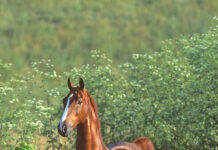
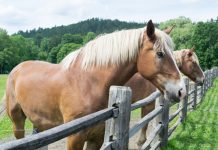
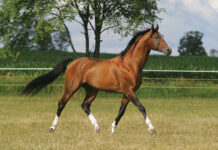

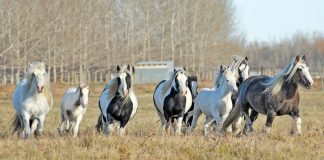

I am 68 years old I was never so pleased as I was tonight. The under standing was made so simple,I will never be so gratefull as I am to night.
good info!
Before Beard joined with Nicols she was in Lexington and she really helped me getting out of a few quirks I had picked up over the years riding. Wished we were closer so I could have a lesson with 1 of my horses. Thought their article was a great outline starting a horse. Need all the help I can with this new horse…… 🙂
I just returned from visiting the Kentucky Horse Farm in Lexington, KY. I learned a lot there especially in the 2 museums. This article about the gaits was very helpful in completing my scrapbook pages of our trip.
I ride the American Saddle Bred. In my opinion thier the best breed! I mostly ride three gaited horses, but five gaited horses have some of the smoothest gait. The slow Gait and rack are the most smoothest gaits i have ever ridden. Well I have never racked but have slow Gaited many times. If you ever get the chance to ride a saddlebred, you will see how smooth they are!
AWESOME! We want more! There are not really very many books written on training saddlebreds or some of their “foreign” equipment used to train.
I own a Saddle Bred, but I have never gotten him to rack. (at least I have never noticed him racking, but I might just not reconize it). He does have the rocking-horse canter, and the smooth trot. I want to know more about this so I can have a gaited horse who can actually rack!
I have had many breeds but once a saddlebred graced my life, my home and my family it became a part of your lives to the end. This is a very smart breed and loyal as the day is long. They are great in the show ring, a partner in life and on the trail. Once you own one you will not look for another breed…warning…if your like me you can never own “JUST ONE”! We have many and have raised them for some years now. We specialize in spotted horses of talent and breeding most all tied to the Scripps Miramar lines, a new introduction of Harlem Globetrotter and Sultan’s Great Day to name a few …
I have an American Saddlebred showing in Hunter divisions. He does not move like a hunter, thus rarely pins in hack (flat) classes, but what a grand jumper he is.
I have recently purchased a new 5-gaited mare and am just starting to learn how to ride her. this was very helpful.
Wait a second, the way this article reads, they’re putting saddles and mounting up on yearlings! Tell me I misread “the fall of their first year” and that actually means they’re older than one year old!
I’ve never met a Saddlebred I didn’t like. They are absolute mind readers, at once proud and gentle. Though I admire all aspects of equine sport, riding a five gaited horse is an extreme pleasure. This article is wonderful in its explanation of how Saddler trainers get the job done. Western horse lovers have so many “how to” articles from which to gather information, so many clinics,etc. that it’s a grand idea to get the basic training plan for young Saddlebreds out there in plain, simple language for all to see. Thanks!
excellant article; As a lifetime member of american quarter horse association for over 30 years, I welcome the change. The saddlers look so alive and beautifull.
Good article.
They may not be sorted but the one in the second photo has some pretty strange looking front feet.